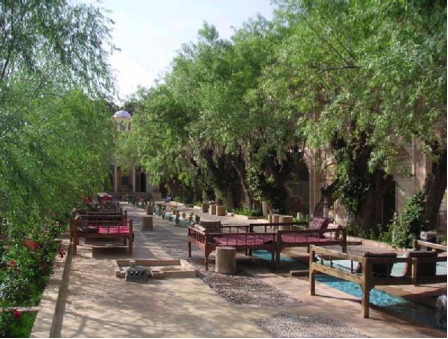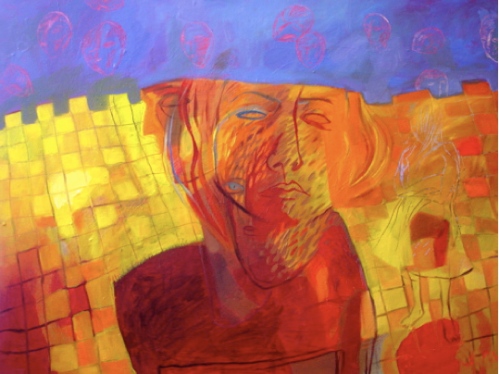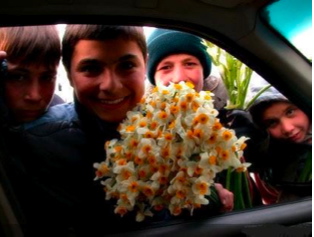Greetings again!
Many thanks for all your kind messages and for forwarding to friends.
Within minutes of sending out a new “Window,” I receive thank you
messages from a wide range of places in the world! I feel amply rewarded
for the work I put into each window. Sometimes, you write with a
specific query about a book or a film you want to use in class. Given my
current teaching and departmental responsibilities, please allow
approximately two weeks for a response.
I number the windows so we have a simple way to keep track. Please let
me know if there are missing numbers in the windows you have received,
JoAnn or I will forward them to you.
Current Issues
* Since you are likely to read this message tomorrow, I would like
to share with you a beautiful and moving piece of music written by
the Iranian musician Kourosh Taqavi for the traditional Persian
instrument setar, dedicated to the victims of 9/11 tragedy. Setar
is a small long-necked lute, an intimate instrument known for its
ability to express emotion. You will see a picture of it. Please
be sure to listen to the whole excerpt (5 minutes):
http://www.iranian.com/Music/2001/September/Kourosh/index.html
* Last week I criticized NPR for misrepresenting a speech in
persian. This week I must commend the station for the very
informative program “Speaking of Faith” on Islam (touching on Iran
as well) aired this morning, 9:00-10:00. The panorama of voices
and views was refreshing. Among the Iranian American scholars
interviewed were Omid Safi (UNC), and Seyyid Hossein Nasr (George
Washington).
Suggested Reading: in relation to discussions surrounding the
anniversary of September 11, I would like to recommend a volume edited
by Professor Safi, good for personal as well as classroom use:
Progressive Muslims: on Justice, Gender, and Pluralism (Oxford:
Oneworld, 2003).
* Iran continued to be in the papers. LETTER FROM IRAN: A
Different Face of Iran (Steven Knipp) in last Sunday’s Washington
Post is notable. Knipp observes: “what astonished me the most
about Iran were its women. I met and spoke with scores of them
from all parts of the country. And everywhere they were
wonderful: vivid, bold, articulate in several languages,
politically astute and audaciously outward-looking. While some men
demurred, the women weren’t afraid to voice opinions about
anything under the sun.” Not surprisingly, Knipp feels the need to
explain: ” In fact, women in Iran can work and drive and vote, own
property or businesses, run for political office and seek a
divorce. The majority of Iran’s university graduates are women.”
Sadly, the negative language that usually characterizes all media
reports on Iran surfaces in this well-intentioned letter as well
when the author expresses hope that: “this once noble nation will
one day return to its tolerant roots.” Similarly, the subtitle
for the letter reads: “An American finds hope in the Forbidden
Land.” Why forbidden land? What is forbidden? It is not clear. The
reader might assume (wrongly) that getting in and out of Iran is
not possible.
* Last week, Iran was in the news for a specific reason: a visit by
the former Iranian president Mohammad Khatami. He was here to
deliver the keynote address during the three-day annual event that
brought together approximately 40,000 Muslims: Islamic Society of
North America convention in Rosemont. The U.S. Deputy Secretary of
Defense Gordon England, Ingrid Matteson, the Society’s first
female president, and Robert Fisk, the celebrated British
journalist were among the speakers. Khatami’s address titled,
“Achieving Balance in a Troubled World,” focused on the complexity
of human identity and the need for American Muslims to acknowledge
the American as well as the Muslim component of their identity.
Chicago Sun-Times had a report on the convention if you like to
read more:
http://www.suntimes.com/output/religion/cst-nws-islamic01.html
* In a news conference held at the National Cathedral, Khatami
condemned committing violence in the name of any religion as a
double crime — one against humanity, and one against religions
which are “based on faith and love.”
Art/Culture
* Let us use the subject we are on to transition from politics into
art! In Iran, Khatami is best known for his support of arts,
particularly performing arts. Last year, the young Iranian super
star, actress Pegah Ahangarani
http://en.wikipedia.org/wiki/Pegah_Ahangarani
staged a show about Khatami in December 2005 to mark the ending of
his presidency. The show called ” A Night with the Man with a
Chocolate Robe” drew a large crowd and many reviews in the Iranian
media. Khatami joined the ladies on stage and spoke about the
significance of supporting and furthering his legacy of reform:
http://en.wikipedia.org/wiki/Mohammad_Khatami
* I know, I know my “windows” have often focused on women. It isn’t
my fault, as Knipp observed, there are many bright articulate
Iranian ladies making their artistic/intellectual statements. I
promise more attention to male contributions soon! For now, I
would like you to meet one more of my favorite Ladies of current
Iranian Cinema: internationally acclaimed writer and director,
Tahmineh Milani. Last time I went to see one of her films “Two
Women” in Iran, the wait in line for the ticket was one hour.
Milani has addressed many social issues, most of all those related
to women, family and gender. For a short bio and list of her
films, visit:
http://www.iranchamber.com/cinema/tmilani/tahmineh_milani.php
* And one more lady from Iranian cinema: Niki Karimi. Karimi started
with acting, worked closely with Milani, and moved into script
writing, documentary making and most recently directing. She has
won national fame, and many awards, for all of them. You may read
more about her and her films in:
http://www.nikikarimi.ir/biography.htm
Suggested Reading: Since we focused mostly on cinema, let me suggest a
good reading on the history of Iranian cinema and its recent
developments: The New Iranian Cinema: Politics, Representation and
Identity. The volume is edited by Richard Tapper and has contributions
from various scholars of Iranian cinema including Hamid Naficy.
Visual Delight
* It has turned into a tradition to close the window after a stroll
in a painting exhibit. Let us visit a 2006 exhibit by Neda Chaychi
born in 1971. In addition to her training as an artist, Neda has a
degree in clinical psychology. She has had many exhibits in the
last few years in Iran. As you see, women images are prominent in
her work: http://www.elahe.net/thumb.php?gallery=317
Until Next Window!
Fatemeh
========================
Fatemeh Keshavarz, Professor and Chair
Dept. of Asian and Near Eastern Languages and Literatuares
Washington University in St. Louis
Tel: (314) 935-5156
Fax: (314) 935-4399
========================


